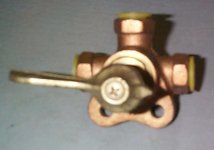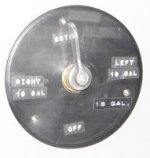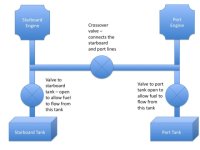kevin ware
New member
- Joined
- Jun 27, 2011
- Messages
- 93
- Reaction score
- 0
- C Dory Year
- 2007
- C Dory Model
- 255 Tomcat
- Vessel Name
- El Gato Thomas
Has anyone installed a fuel control panel in a Tom Cat?
We find ours typically lists to starboard most of the time as the galley, water tank and a number of other items on that side make it heavier. One solution would be to burn down the starboard tank first, but to do that one would need a fuel tank control panel, so that the s/b tank would feed both engines.
It would not be a bad idea just for safety reasons. If one tank was contaminated, you could run both engines off the remaining, (hopefully) clean tank.
If anyone has installed such a system, it would be handy to know what you did, and how you did it. Some photos would also be useful.
Another solution to the listing problem, is to move the house batteries from the center of the stern, to the closet just inside the door on the port side. If dry cells, this would be OK, and I think a number of folks have done that. If so, how much did it help the list?
Finally, due to the s/b list, when the boat is heavy the cockpit drain on the s/b stern is at or slightly below the water line. Water then runs inboard to the fish box, and in the end winds up in the bilge. Has anyone plugged the cockpit drain on the s/b side to stop this from happening? If so, what did you use?
Kevin Ware
El Gato Tomas
CD Tom Cat 25.5
We find ours typically lists to starboard most of the time as the galley, water tank and a number of other items on that side make it heavier. One solution would be to burn down the starboard tank first, but to do that one would need a fuel tank control panel, so that the s/b tank would feed both engines.
It would not be a bad idea just for safety reasons. If one tank was contaminated, you could run both engines off the remaining, (hopefully) clean tank.
If anyone has installed such a system, it would be handy to know what you did, and how you did it. Some photos would also be useful.
Another solution to the listing problem, is to move the house batteries from the center of the stern, to the closet just inside the door on the port side. If dry cells, this would be OK, and I think a number of folks have done that. If so, how much did it help the list?
Finally, due to the s/b list, when the boat is heavy the cockpit drain on the s/b stern is at or slightly below the water line. Water then runs inboard to the fish box, and in the end winds up in the bilge. Has anyone plugged the cockpit drain on the s/b side to stop this from happening? If so, what did you use?
Kevin Ware
El Gato Tomas
CD Tom Cat 25.5



